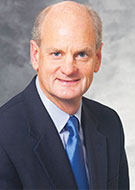RSNA/AAPM Symposium
Together We Can Make a Difference: Radiology/Physics Collaboration in the Development of New Imaging Techniques

The development of new imaging methods is almost always inspired by clinical need, enabled by advances in technology, and disseminated through partnerships with industry. The interdisciplinary collaborations between medical physicists who leverage these technical advances to solve clinical problems identified by practicing radiologists are critical factors in the success of our field. Likewise, translation of these new methods into clinical practice requires partnerships beyond the walls of academia.
In their lecture, Thomas M. Grist, MD and Charles A. Mistretta, PhD, will discuss a series of X-ray, MRI and CT techniques for diagnostic and interventional angiographic applications and the individuals and events that contributed to their development.
An investigative researcher focused on the development and application of advanced MRI techniques for the diagnosis and therapy of human disease, particularly for the evaluation of cardiovascular disorders, Thomas M. Grist, MD, bridges the gap between the physics of imaging science and clinical practice.
Dr. Grist is a professor and chair of radiology at the University of Wisconsin, Madison, and the John H. Juhl Professor of Radiology, Medical Physics and Biomedical Engineering at the UW School of Medicine and Public Health, where he has been on faculty since 1991.
During his tenure as chair, the radiology department has increased the number of clinical faculty, fellows and residents. Together with colleagues in medical physics, Dr. Grist established the Imaging Sciences Center in the Wisconsin Institutes for Medical Research, a state-of-the-art facility devoted to the development of imaging technologies and their translation to clinical practice. His research has resulted in 16 patents.
Dr. Grist is chair of the R&E Foundation Board of Trustees. He has served as member of the RSNA Quantitative Imaging Biomarker Alliance (QIBA) Task Force.
He is a past president of the International Society for Magnetic Resonance in Medicine (ISMRM). He has been named a fellow of the American Heart Association, ISMRM, the American Institute for Medical and Biological Engineering (AIMBE) and ACR. He received a distinguished investigator award from the Academy for Radiology & Biomedical Imaging Research. He is a member of the editorial board of Magnetic Resonance Imaging and serves as a reviewer for a number of scholarly journals.
He received his medical degree from the Medical College of Wisconsin, Milwaukee, and completed his radiology residency at Duke University in Durham, NC.
An esteemed researcher with a deep interest in safer diagnostic angiographic interventions, Charles A. Mistretta, PhD, is considered one of the primary architects of modern time-resolved angiography. Dr. Mistretta is the John R. Cameron Professor in the Departments of Medical Physics, Radiology, and Biomedical Engineering at the University of Wisconsin, Madison. He received his PhD from Harvard University in Cambridge, MA. His research began with the development of digital subtraction angiography, which was then extended to MR angiography. He is now working on methods to reduce radiation dose in CT fluoroscopy by a factor of 500 and CTA methods to determine coronary artery velocity and pressure. His research has resulted in more than 55 patents in the U.S. and globally. He has also been awarded multiple NIH grants, including several RO1 grants. Dr. Mistretta received the 2010 RSNA Outstanding Researcher award, the Edith Quimby Award for Lifetime Achievement from the AAPM, the Marie Curie Skłodowska Award from the International Organization for Medical Physics, and the J. Allyn Taylor International Prize in Medicine from Robarts Research Institute. He also was awarded the Medal of Innovations in Healthcare Technology from the Institute of Electrical and Electronic Engineers.